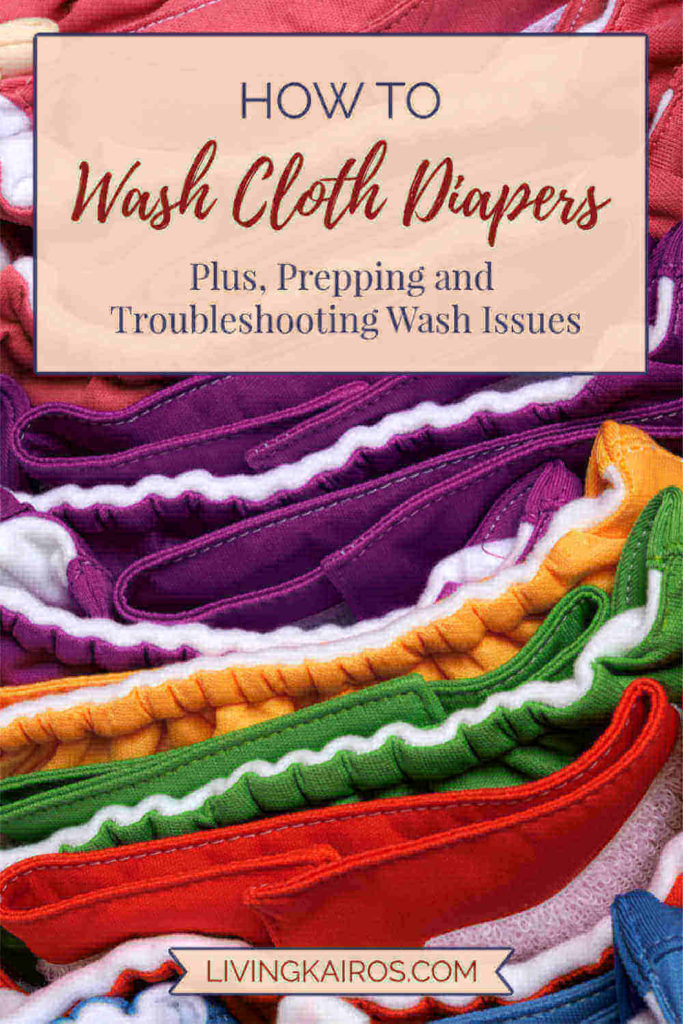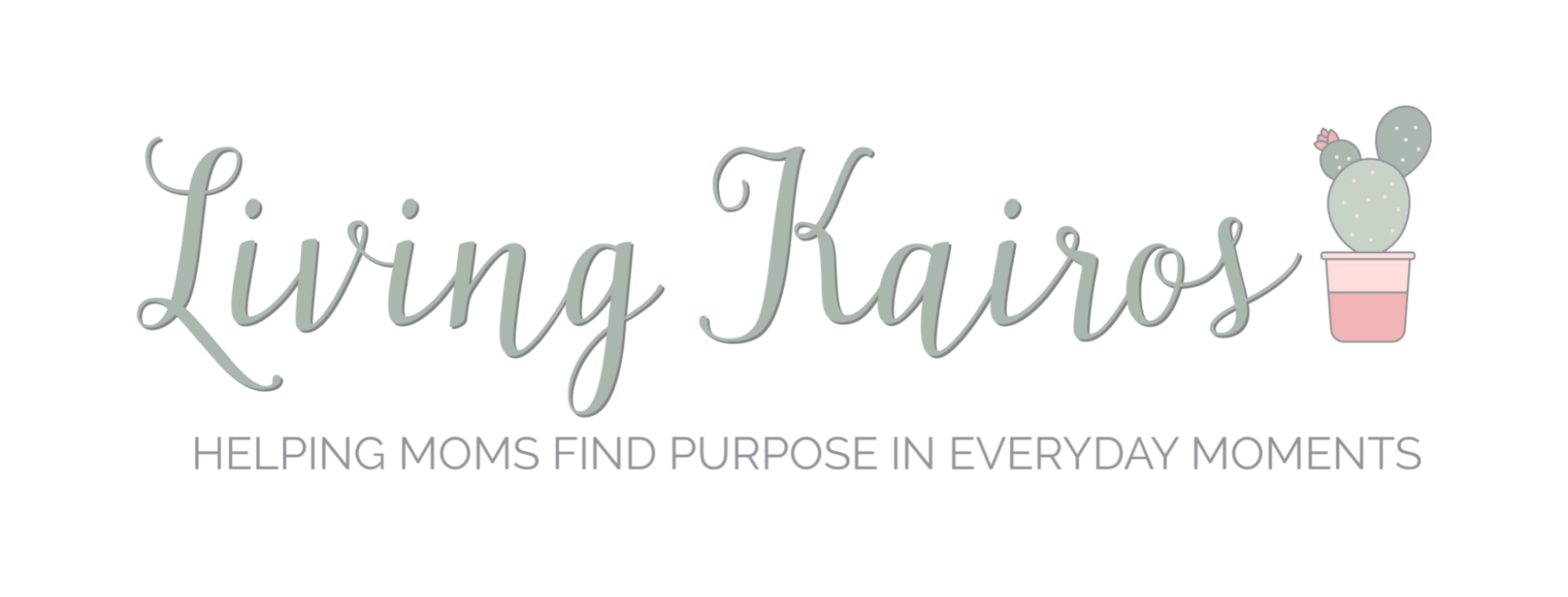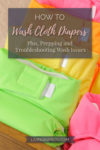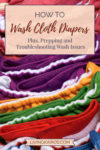Many moms are intimidated at the thought of how to wash cloth diapers. And whether you buy your diapers new or previously loved, all diapers need a certain amount of prep before you put them on your sweet baby. Although prepping and washing cloth diapers sounds scary, both are really much easier than you think!

Congratulations on choosing to cloth diaper your baby! Cloth diapering is an adventure, but so worth it. Now that you have your diapers in hand, you may wonder where to start. The first step is to prep your cloth diapers.
These instructions are for a standard washing machine (with a spiral agitator).
How to Prep Cloth Diapers
How to prep new cloth diapers
New diapers require a little less prep than used diapers (depending on how you look at it), but don’t skip it! Brand-new diapers need some attention, otherwise they won’t absorb correctly.
Start by removing the inserts (for pockets). Put all the diapers (inserts, etc.) in the wash. Do not over or under-fill the washer. You want the diapers to rub against each other, but don’t add so many that they can’t move around in the drum. Fluff Love University uses the stew analogy: when you open the washer, you want it to look like diaper stew. If it looks like soup, you have too few diapers; if it looks like chili, there are too many diapers. Generally, fifteen to eighteen diapers is perfect for a normal load.
Fluff Love states you must prep cloth diapers differently depending on the material.
For synthetic materials (microfiber, etc.) and bamboo inserts, Fluff Love advises just wash one time, dry, and use. However, when I get new diapers, I prefer to wash at least twice to get anything from the manufacturer or distributor out before I put them on my baby.
For hemp and cotton, Fluff Love advises to wash twice with hot water and detergent without drying between washes. But I’ve found that these natural inserts need to be washed at least three times and dried in between washes to increase the absorbancy.
I exclusively use pocket diapers, with a combination of microfiber and hemp/cotton blend inserts. Prep these cloth diapers by washing the “shells” (or the main part of the diaper containing the cover and pocket) and microfiber inserts once without detergent detergent in hot water, and a second time with detergent in hot water. I wash the hemp/cotton inserts once without detergent in hot water, and twice with detergent in hot water, drying them in the dryer between washes. Note: the first two hemp/cotton insert washes are done with the shells and microfiber inserts.
How to prep used cloth diapers
Buying used cloth diapers is one of the huge money-saving hacks in the cloth diapering world. Most cloth diapers hold up extremely well, and many moms sell them once they finish having babies. I bought about half of my cloth diapers used, and they are fantastic. When prepped properly, putting used diapers on your baby is completely fine!
Some moms choose to strip their used cloth diapers, but I don’t because it’s extremely hard on the diapers. Instead, I prep used cloth diapers by doing a sanitize wash with bleach:
First remove the inserts (for pockets). Put all the diapers (inserts, etc.) in the wash. Again, about fifteen to eighteen diapers is a good load size. Do a warm wash with detergent. Next, do a hot wash with detergent and ¼ cup bleach. Use regular bleach, not scented, splashless, or color-safe. Just plain old chlorine bleach. Don’t worry, the bleach won’t mess up the colors of your diapers because it’s properly diluted. Finally, do another hot wash without detergent to rinse out all the bleach.
You don’t need to dry natural inserts between washes when prepping used cloth diapers. Most likely, they have been used and washed so many times, the absorbancy is really good.
How to wash cloth diapers
What turns many people off to cloth diapers is all the work they think goes into washing them. I’m not going to lie, it takes a little extra time, but I’m so used to it at this point, it doesn’t even bother me. It’s part of my regular weekly washing.
Frequency
Wash cloth diapers every 3-4 days. Any longer between washes, and you run the risk of mildew, mold, and bacteria growing. Yuck! You may need to wash more often depending on how many diapers you have, and how many your baby goes through each day.
For example: right now, both my littles are in cloth. I have around 30 newborn size diapers and around 40 larger diapers. When Little Miss was born, she went through 12-15 diapers per day, so I had to wash almost every day and a half. Now she goes through about 10-12 (at 3.5 months old), and I can get away with washing every two days or so. Little Man just turned two, and we are right on the verge of beginning potty training. He goes through maybe six diapers each day, so I wash his much less frequently.
This is my current washing schedule with two kids in cloth (3.5 month old baby and 2 year old):
- Saturday: Wash both kids’ diapers
- Sunday: Wash baby diapers
- Monday: None
- Tuesday: Wash baby diapers
- Wednesday: Wash both kids’ diapers
- Thursday: None
- Friday: Wash baby diapers
Again, it sounds like a lot, but I’m so used to it now that I get it done really fast.
How to wash cloth diapers
Many moms have their own way of washing their cloth diapers, but this is what works for me. Again, I have a top-loading machine with a spiral agitator.
First, do a cold cycle without detergent. This gets rid of all the yucky stuff. Remember, exclusively breastfed babies’ poop is water soluble and doesn’t need to be rinsed out before putting in the wash. Formula fed babies and babies who are eating solids have poop that is not water soluble, and it needs to be rinsed before putting it in the wash. I have this Bumworks Cloth Diaper Toilet Sprayer and Spray Pal shield, which make getting poop off super easy.


Second, wash your cloth diapers in a hot cycle with detergent. See Fluff Love’s detergent index to find out how much detergent you should use.
Finally, do an extra cold rinse. I usually only do this if I think I have soap buildup on my inserts, but you may want to do it every time depending on your water hardness.
Drying cloth diapers
You can dry cloth diapers in the dryer, but be warned: the heat is not great for elastics. If you choose to use the dryer (and I do in a pinch), make sure to tumble dry on a low heat setting. Since I use pocket diapers, I dry my inserts in the dryer on a medium heat setting, and line dry my shells.
This is the most cost-effective way to dry your diapers because all you need is air. I generally hang my diapers in my laundry room with regular, plastic clothes hangers (don’t use metal because they may rust). I can usually get about three diapers per hanger. Hang the diapers from the middle so there is less stress on the elastics.
You can also hang your diapers on an outdoor clothesline. This is especially good if you have stains because the sun will bleach them out.
Folding cloth diapers
All-in-One cloth diapers are super easy to fold because the insert is built in. Pockets take a little more work because you have to “stuff” them. Some moms dump both shells and inserts into a drawer or bin and stuff the diapers as they need them. I prefer to stuff all my diapers at the same time so I don’t have to worry about it when I’m in a hurry. But do whatever works best for you!
Cloth diaper storage
I want to add a quick note about storing cloth diapers. Any drawer or bin is completely fine, but avoid putting them in a plastic storage bin or bag. This will ruin the elastics. When you no longer need your diapers, store them in a breathable container in your closet, attic, etc.
Troubleshooting common issues related to washing cloth diapers
If you have a good wash routine, you most likely won’t run into any washing issues, but here are a few that can creep up.
Absorbency
If your cloth diapers don’t seem to absorb as well as they used to, you may have a couple of problems.
Soap buildup
Soap buildup is one of the most common issues I’ve faced with my diapers. To test if you have soap buildup, run your diapers through a cycle without detergent. While the load is running, check to see if there are any soap bubbles or foam in the water. If you see some, chances are you have soap buildup. But it’s an easy fix! After you complete your normal wash routine, run a few cycles in cold water without any detergent. When the bubbles are gone, you should be good to go.
Hard water
Another issue that can cause absorbency problems is hard water. If you checked for soap buildup and still have an issue, check your water hardness. You buy inexpensive water harness kits to determine if you need a water softener.
Stains
Most good-quality cloth diapers don’t stain, but every now and then your wee one may have a particularly nasty poo that does what appears to be serious damage. Never fear! After a regular wash, line dry the stained diaper in the sun. The sunlight bleaches out stains (and you don’t need to use any nasty chemicals on your diapers!).
Odor
Again, if you established a good wash routine, you shouldn’t have odor problems. But if your diapers smell off, it may be time to sanitize. Run your diapers through the process described above for prepping used cloth diapers. If that doesn’t work, a strip may be required. Since I’ve never had to strip my diapers, I’m not an expert in that area. But check out Fluff Love University for instructions on stripping your cloth diapers.
See? Prepping cloth diapers isn’t as scary as you thought, right? And washing is much simpler than you imagined, right? The more often you do it (and let’s face it, you’ll wash your cloth diapers alot!), the quicker it goes. Get in your own little routine, and I promise you won’t even miss disposables.



